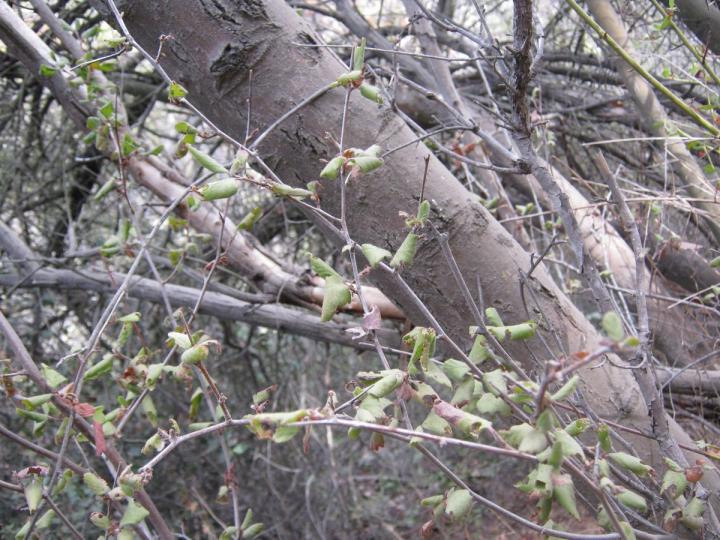
UCLA Study Reveals Plant Survival Strategies in Drought Conditions

Researchers measured leaves' drought tolerance at the "turgor loss point" -- the level of dehydration that causes them to wilt.
Credit: Lawren Sack
The research will improve predictions of which plant species will survive the increasingly intense droughts associated with global climate change.
The research is reported online by Ecology Letters, the most prestigious journal in the field of ecology, and will be published in an upcoming print edition.
Predicting how plants will respond to climate change is crucial for their conservation. But good predictions require an understanding of plants' ability to acclimate to environmental changes, or their “plasticity.” All organisms show some degree of plasticity, but because they're stationary, plants are especially dependent on this ability.
“Plants are masters of plasticity, changing their size, branching patterns, leaf colors and even their internal biochemistry to adjust to changes in climate,” said Lawren Sack, a professor of ecology and evolutionary biology in the UCLA College and the study's senior author.
Little has been known about the degree to which plastic changes might allow plants to endure worsening droughts.
“Plants have evolved this amazing ability to sync with their environment, but they are facing their limits,” said Megan Bartlett, a UCLA doctoral student in ecology and evolutionary biology and the study's lead author.
Compiling and analyzing data for numerous species from various ecosystems around the world, Bartlett found that most species accumulate salts in their cell sap to fine-tune their tolerance to seasonal changes in rainfall. But that adjustment only provides a relatively narrow degree of additional drought tolerance.
Saltier cell sap gives plants the ability to continue to grow as soil dries during drought. Unlike animal cells, plant cells are enclosed by cell walls. To hold up the cell walls, plants depend on “turgor pressure” — the pressure produced by internal water pushing against the inside of the cell wall. As the cells dehydrate, the turgor pressure declines until the cell walls collapse, and the leaf becomes limp and wilted.
The team of biologists collected data on the “turgor loss point” — the level of dehydration that causes leaves to wilt. Plants that have a lower turgor loss point can lose more water before wilting, and can keep open their pores, or stomata, to take up carbon dioxide for photosynthesis in drier soils.
“During a drought, plants have to choose between closing their stomata and risking starvation, and continuing to photosynthesize and risking cell damage from wilting,” Sack said.
Previous research by the UCLA team revealed the key mechanism plants use to adjust their turgor loss point during drought. Plants load their cells with salts, which attract water molecules and limit turgor loss. In wet conditions, plants invest fewer resources in producing and accumulating these solutes and reduce the saltiness of their cell sap.
Drawing on both new data they produced and previously reported data for hundreds of species, the scientists determined the overall picture of how much plant species adjust their cell sap saltiness to maintain turgor and continue to grow during drought.
“For most plants, these adjustments were small,” Sack said. “This means they have only limited wiggle room as droughts become more serious. On the plus side, this discovery means we can estimate species' drought tolerance relatively simply. We can make a reasonable drought tolerance measurement for most species regardless of time of year or whether we are sampling during wet or dry conditions.”
Bartlett said the finding is good news for plant biologists. “It means that predicting how a species will respond to climate change from one season of drought tolerance measurements is a reasonable place to start,” she said. “Our predictions will be more accurate when we take plasticity into account, but sampling in one season is a reasonable simplification for really diverse ecosystems, like tropical rainforests.”
All ecosystems potentially vulnerable
The researchers expected plants' plasticity to be very different based on whether they live in deserts, which may get less than an inch of rainfall per year, or rainforests, which may receive more than 10 feet. Instead, they found relatively small differences across ecosystems, meaning that plants are potentially vulnerable no matter where they live, the scientists said.
The researchers also compared plasticity for crops. They found a strikingly contrasting result: Whereas differences in plasticity among wild species were relatively small and unimportant, among the varieties of certain crop species — such as coffee and corn — greater plasticity resulted in improved drought tolerance.
“It's been suspected for a long time that plasticity in cell saltiness might improve crop drought tolerance, so it makes sense that we found impressive differences among crop cultivars and that these differences translate into drought tolerance,” Bartlett said. “Our study points to plasticity in turgor loss point as an especially important focus for breeding and selecting drought tolerant cultivars.”
The research was funded by the National Science Foundation's Graduate Research Fellowship Program and East Asia and Pacific Summer Institute, the Smithsonian Institution's Center for Tropical Forest Science – Forest Global Earth Observatory, the Vavra Research Fellowship and UCLA's department of ecology and evolutionary biology.












